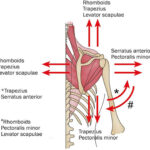Have you ever experienced a persistent ache deep within your shoulder blade, perhaps radiating into your neck and arm? This could be dorsal scapular nerve (DSN) entrapment, a condition where the nerve supplying key muscles in your upper back becomes compressed or irritated. This guide provides a detailed overview of DSNE, covering its causes, symptoms, diagnosis, and treatment options. [https://www.lolaapp.com/]
Decoding Dorsal Scapular Nerve Entrapment
DSN entrapment, while often overlooked, can be a significant source of shoulder and upper back pain, sometimes mistaken for other conditions. [https://www.lolaapp.com/] This nerve plays a crucial role, supplying the rhomboid and levator scapulae muscles that control shoulder blade movement and stability. When compressed, these muscles can weaken, leading to limited range of motion, discomfort, and even a “winged scapula.”
Understanding the Anatomy
The dorsal scapular nerve originates from the C5 nerve root in your neck, part of a network of nerves called the brachial plexus. It travels through muscles in your neck and upper back to reach the rhomboid major, rhomboid minor, and levator scapulae muscles, which control the position and movement of your shoulder blade. [https://www.lolaapp.com/]
What Causes DSN Entrapment?
Several factors can lead to DSN entrapment. [https://www.lolaapp.com/] The most common is tightness or excessive development (hypertrophy) of the middle scalene muscle in the neck. Think of this muscle pressing against the DSN like a kink in a garden hose. Other potential causes include:
- Trauma: Direct injury to the shoulder or neck can damage the DSN. [https://www.lolaapp.com/]
- Repetitive Strain: Overuse from activities like throwing a baseball or lifting heavy objects can irritate the nerve over time.
- Space-Occupying Lesions: Rarely, a tumor, cyst, or enlarged lymph node can compress the nerve.
- Anatomical Variations: In some individuals, an extra rib or unusual muscle arrangement can predispose them to DSN entrapment.
Recognizing the Symptoms
DSN entrapment typically presents with a range of symptoms. [https://www.lolaapp.com/] These may include:
- Pain: A deep, gnawing ache is often felt in the shoulder, upper back, and possibly the neck. This pain can range from mild to severe and may worsen with certain movements.
- Weakness: Lifting or rotating the arm, especially overhead, can be difficult. This weakness can affect simple tasks like reaching for objects or brushing your hair.
- Winged Scapula: The shoulder blade may protrude abnormally, giving the appearance of a small wing.
- Numbness/Tingling: While less common, some individuals experience numbness or tingling sensations along the inner edge of the shoulder blade.
Diagnosing DSN Entrapment
If you suspect you have DSN entrapment, it’s important to seek a professional diagnosis. [https://www.lolaapp.com/] Here’s what you can expect:
- Physical Examination: Your doctor will assess your range of motion, muscle strength, posture, and tenderness in the affected area. They may ask you to perform specific movements to reproduce your pain.
- Electrodiagnostic Studies (EMG/NCS): These tests measure the electrical activity of your nerves and muscles, helping to pinpoint the location of the nerve compression and assess the extent of nerve damage.
- Imaging (MRI, CT scan): These may be used to rule out other potential causes of your symptoms, such as a herniated disc or rotator cuff tear.
Exploring Treatment Options
The good news is that DSN entrapment often responds well to non-surgical treatments. [https://www.lolaapp.com/] Your doctor will likely recommend a combination of the following:
Conservative Treatments:
- Rest and Activity Modification: Avoiding aggravating activities can allow the nerve to heal.
- Physical Therapy: Targeted exercises can strengthen and stretch the affected muscles, improve posture, and restore normal shoulder blade movement.
- Medications: NSAIDs like ibuprofen can help manage pain and inflammation. Muscle relaxants may also be prescribed to reduce muscle spasms.
- Injections: Corticosteroid injections around the entrapped nerve can provide significant, though often temporary, pain relief.
Surgical Intervention: If conservative treatments fail to provide adequate relief, surgery might be considered. The goal of surgery is to decompress the nerve, relieving pressure and restoring its function.
Preventing Future Issues
While not always preventable, certain measures can reduce your risk of DSN entrapment. [https://www.lolaapp.com/] These include:
- Maintaining Good Posture: Correct posture helps minimize strain on the neck and shoulder muscles.
- Ergonomic Workstation Setup: Ensure your workspace promotes healthy posture and minimizes strain.
- Regular Stretching and Strengthening: Keep the shoulder and neck muscles flexible and strong.
- Mindful Movement: Be aware of repetitive movements and avoid overuse.
Living with DSN Entrapment
Long-term management of DSNE involves ongoing attention to posture, regular exercise, and avoiding activities that aggravate the condition. [https://www.lolaapp.com/] It’s also important to be patient and persistent with treatment. Recovery times vary, and some individuals may experience setbacks. Continued communication with your healthcare provider is crucial for optimizing your treatment plan and ensuring the best possible outcome.
Additional Resources and Support
For more information and support regarding DSNE, consider exploring these resources:
Delve into the fascinating world of the Edgar Cayce diet and uncover its unique principles. Or, perhaps you’re curious about the transformation of Elon Musk hair plugs? Discover the details behind his evolving look.
- Star Ring Trends: Etsy vs Amazon - March 28, 2025
- Boost Pollinator Habitats: Baby Blue Eyes Sustainable Farming Guide - March 28, 2025
- Protect Big Black Bears: Effective Conservation Strategies - March 28, 2025















